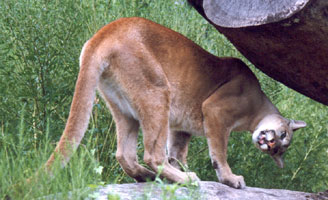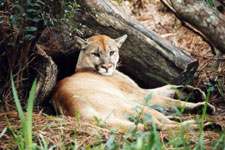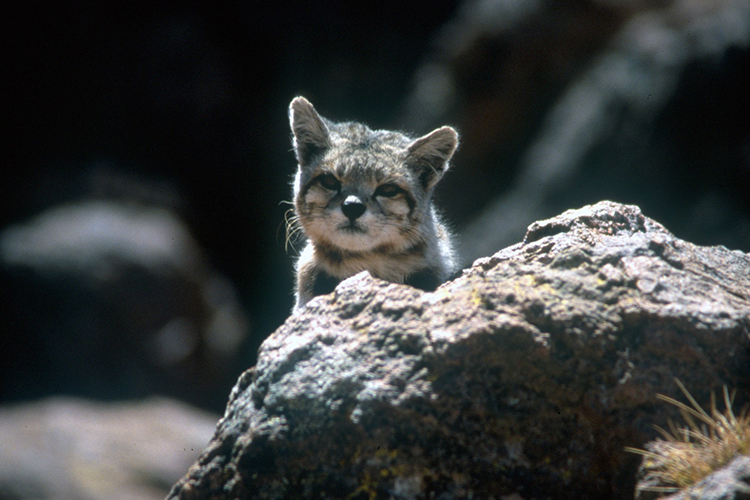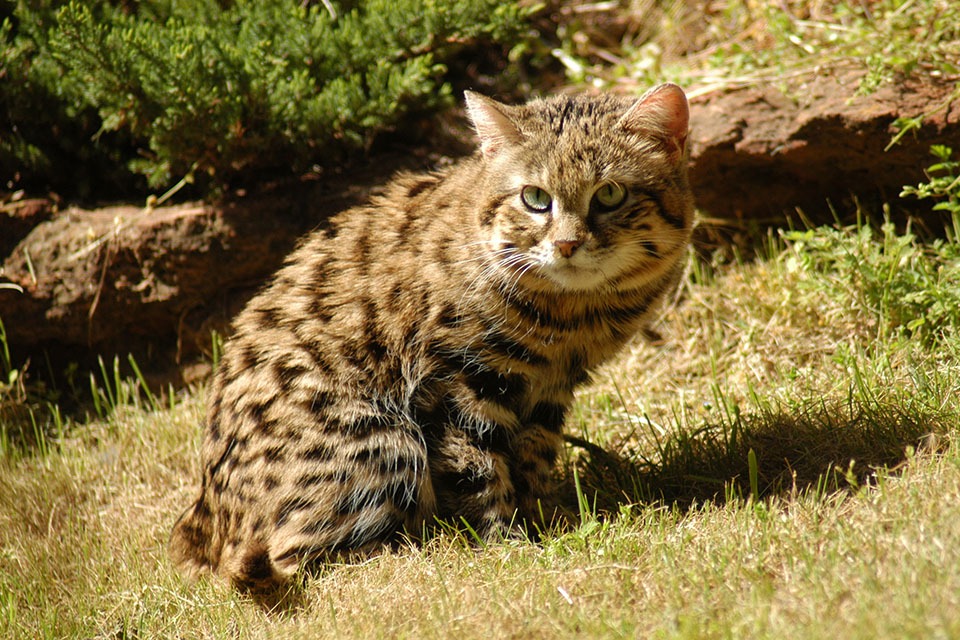Florida Panther Facts
Protect the Florida Panther
or Lose Her Forever
What is the Species?
Puma concolor coryi. The Florida Panther is a unique subspecies of cougar that has adapted to the subtropical environment of Florida. Schoolchildren picked the panther as the state animal in 1981. This large charismatic umbrella species is the mascot for dozens of schools across the state and tens of thousands of residents have paid a premium for a specialty “Protect the Panther” Florida license plate, sold to pay for the state’s panther research.
How Many Panthers Are Left?
In 2010, the population had grown from about 25 adults in 1995 to roughly 100. In 2015 the state estimated their population to be 100 -180. In 2017, the Florida Fish & Wildlife Conservation Commission updated the population estimate to between 120 – 230 panthers still remaining in Florida, making this one of the rarest and endangered mammals in the world. Even at their best estimates, 230 panthers are not a sustainable population size. The Florida panther is currently listed as endangered and is protected under the Endangered Species Act.
Where is their Habitat & Range?
The Florida panther is mostly confined to Southwest Florida, usually in pinelands, hardwood hammocks, and mixed swamp forests. Adult males may range over an area of 200 square miles, while females range over a 70 to 80 square mile area. Florida panthers are very solitary animals. An adult maintains a home range to live, hunt and, if female, raise its young alone. A male panther’s home range is very large and averages 275 square miles and overlaps with the smaller home ranges of females. Panthers maintain boundaries by marking with scents. They rarely fight over territory.
The Florida Panther is an umbrella species, which means they are the heart of the ecological community within their habitat. Protecting panthers in Florida indirectly conserves other threatened and endangered wildlife in the state.
General: Panthers are most active at dusk and dawn, they can travel 15-20 miles a day, often moving in a zig-zag pattern, though they tend to rest during the daytime, travel & hunt during the cooler hours of the night. Panthers can swim and will cross wide bodies of water. They have a keen sense of smell and a field of vision of 130 degrees, they have excellent depth perception but lack the panoramic view that deer have.
They can run up to 35 mph but only for a few hundred yards, their preferred method of hunting is to creep up as close to their prey as possible and launch a short spring attack. Panthers do become used to man-made noises and frequently crossroads. They are attracted to woodland fires and may stay near burned sites for days as deer and other prey are drawn to new vegetation. When humans approach an area they will either be still, disappear, or attempt to circle behind. Panthers can live up to between 12-15 years in the wild. A male can measure 7-8 feet from the nose to tail tip and weigh 100-160 lbs. Females are about 6 feet in length and weigh between 60-100 lbs.
The start of 2019 brought exciting news, with a third female panther documented north of the Caloosahatchee River! Having females move north of the river is one of the goals in the panther recovery plan and brings promise for the future of the sub-species.
 What Kind of Hunter is the Panther?
What Kind of Hunter is the Panther?
Efficient is the word. Adult male panthers weigh up to 150 pounds and can measure almost 7 feet long from the nose to the tip of the tail. Females are smaller, rarely weighing more than 100 pounds. Panthers are built to hunt live prey. Deer and wild hogs are their preferred food, but, when these are not available panthers will eat raccoons, armadillos, snakes and even alligators. Interestingly, panthers eating a diet of small animals are not as healthy as those with plenty of deer to hunt. While they are good sprinters, panthers rarely chase prey for long distances. Instead, prey is singled out, stalked and ambushed.
What are the Threats?
Road kills, habitat loss, and development in panther range continue to be threats. Florida panthers are still inching back from the brink of extinction. The construction of new houses, roads, and airports in Southwest Florida continue to squeeze the panthers out and fragment their habitat, increasing the likelihood that cats will be hit by cars.
Humans are one of the panther’s greatest threats. This also means that we can directly affect the panther’s future. It’s sad to say that Florida panthers are killed by cars and trucks, particularly on State Road 29 and Alligator Alley (I-75), and – although it is against the law – hunters also still shoot panthers occasionally. In 2016 a record 34 Florida panthers were killed by vehicle collisions. Road kills took 23 panthers in 2017 and as of April 2018, 14 dead panthers have been discovered 2018.
Florida panthers have an unusually large number of health problems. Most are related to poor habitat conditions and genetic defects. Around the Everglades, panthers have been contaminated with mercury (at least 1 has died from mercury poisoning) by eating raccoons high in mercury, which passes through the aquatic food chain. The mercury’s origin is being debated and is uncertain.
Panther habitat is being lost at a rate of about 1 to 2% annually and panther range counties are among the fastest-growing areas in the nation.
Learn more about the many threats facing the Florida Panther on our Cat Fight page.
What is being done?
Plans to save the panthers focus on 3 areas of action. First, additional habitat must be secured and enhanced. Second, programs are underway to breed panthers in captivity for later release back in the wild. Third, scientists are exploring ways to increase the genetic variability of panthers through cross-breeding with closely related subspecies.
The panther needs large wilderness areas for its survival. Federally listed as endangered since 1967, the Florida panther was once down to 25 individuals. These few animals are threatened by further habitat loss, collisions with cars, the ill effects of inbreeding, and high levels of mercury in their prey.
 Many of the remaining panthers live in or near Big Cypress National Preserve and Everglades National Park. The National Park Service is cooperating with the U.S. Fish and Wildlife Service, the Florida Fish and Wildlife Conservation Commission, the Florida Department of Natural Resources, and other organizations to try to bring about the recovery of the Florida panther. Efforts are centered on research, captive breeding, and public education. Radio-collaring of several panthers has shown what areas and habitat types they use. Other studies have identified the principal prey — white-tailed deer. Publicity has made the public more aware of the panther’s plight and alerted people to watch out for them on the highway. But with the numbers so low and suitable habitat in south Florida so restricted, captive breeding and re-establishment in other areas will be crucial for turning the population decline around.
Many of the remaining panthers live in or near Big Cypress National Preserve and Everglades National Park. The National Park Service is cooperating with the U.S. Fish and Wildlife Service, the Florida Fish and Wildlife Conservation Commission, the Florida Department of Natural Resources, and other organizations to try to bring about the recovery of the Florida panther. Efforts are centered on research, captive breeding, and public education. Radio-collaring of several panthers has shown what areas and habitat types they use. Other studies have identified the principal prey — white-tailed deer. Publicity has made the public more aware of the panther’s plight and alerted people to watch out for them on the highway. But with the numbers so low and suitable habitat in south Florida so restricted, captive breeding and re-establishment in other areas will be crucial for turning the population decline around.
Are There Any Refuges?
The National Wildlife Refuge System Act of 1966 includes measures to preserve ecosystems for endangered species, perpetuate migratory bird species, preserve natural diversity, and create a public appreciation for wildlife protection.
The refuge system is administered by the U.S. Fish and Wildlife Service, an agency of the Department of the Interior. The Florida Panther National Wildlife Refuge is one of the 58 refuges established under the authority of the Endangered Species Act. The refuge area has long been known as an important Florida Panther habitat. Several female panthers have had litters and raised kittens on the refuge in recent years.

The Florida Panther is an umbrella species, which means they are the heart of the ecological community within their habitat. Protecting panthers in Florida indirectly conserves other threatened and endangered wildlife in the state. The Florida Panther Refuge provides habitat for a total of 126 bird species, 46 species of reptiles and amphibians, 22 species of mammals and a large variety of fish. Closed areas in the refuge protect habitat for 24 species of endangered, threatened or plant & animal species of special concern status.
The Florida Fish and Wildlife Conservation Commission monitors panther activity using radio telemetry collars. They fly three times a week to aerially locate each radio-collared panther. These techniques provide vital information to scientists. The swamps and pinelands panthers occupy also provide us with clean air and water, as well as thousands of species of birds, mammals, reptiles, and plants.
From FWC’s 2008 Environmental Assessment for the “Interagency Florida Panther Response Plan”:
“The Florida panther (Puma concolor) is one of the rarest large mammals in the United States. Historically, the panther was distributed from eastern Texas or western Louisiana and the lower Mississippi River Valley, east through the southeastern United States including all of Florida (Young and Goldman 1946). Although occasional sightings and signs were reported throughout the rural southeast between 1950 and 1980, the only confirmed panther population was found in south Florida (Anderson 1983). Geographic isolation of the Florida panther, combined with habitat loss, population decline and associated inbreeding, resulted in significant loss of genetic variability and decline in the overall health of the population. To restore genetic variability, eight female Texas panthers were released in strategic locations within south Florida in 1995. Due to the genetic augmentation, the population grew from less than 50 panthers in 1995 to the current population of 80-100. All offspring of the Texas panthers are considered to be Florida panthers. The panther is listed as endangered under both the Endangered Species Act and Florida law. Increased development into panther habitat has heightened the potential for human-panther interactions, thereby raising public safety awareness issues. Due to the panther’s potential for extinction, conflicts with humans raise issues that require careful consideration and action such that the intent and ability to conserve the species is unaltered while at the same time the safety of the public remains paramount.”
Refuge Location
The Florida Panther National Wildlife Refuge lies 20 miles east of Naples, Florida. Interstate 75 parallels the south boundary; State Road 29 parallels the east boundary.
The Mission of the Panther Refuge
To conserve and manage lands and waters in concert with other agency efforts within the Big Cypress Watershed, primarily for the Florida Panther, other endangered and threatened species, natural diversity, and cultural resources for the benefit of the American people.

Additional Research: In 1989, data collected from 29 radio-collared panthers indicated that the population was losing genetic diversity at a rate of three to seven percent yearly. Researchers believed that the gene pool would continue to erode even if the population stabilized, leading to extinction within 40 years. Three years later, with the health of the population continuing to decline, biologists made a controversial decision. In an effort to increase genetic diversity, wildlife managers introduced several female Texas cougars — the closest remaining cougar population that had historically shared Florida panther range — into the Florida panther population in 1995. Several hybrid litters have since been produced, and the introduction seems to have corrected some of the problems experts generally attribute to inbreeding. Experts are still debating the role of the Texas cougars in panther recovery.
Despite the success of this effort, panthers are still at great risk of extinction. Conserving the panther will require aggressive protections for remaining wild lands in south Florida as well as conservation efforts on private lands.
Another major conservation challenge for the panther is reestablishing the species in other portions of its historic range. Field studies have indicated an adequate prey base and appropriate habitat in some areas of northern Florida. While there is widespread popular support for panther reintroduction in Florida, some people are still concerned about introducing the cat to new areas, fearing the panther will bring with it restrictions on private property uses, potential damage to livestock and pets, and a possible threat to human safety. Such concerns often surround recovery efforts for large carnivores, but with proper assurances to address depredation claims and any potential “problem” animals, reintroduction projects could prove a positive step towards recovering the Florida panther.
What You Can Do To Save The Panther?
- Are you a Florida resident? Slow down when you’re driving and support panther conservation efforts by buying a Protect the Florida Panther license plate.
- Know what to do if you encounter a panther in the wild; i.e. make yourself appear larger, avoid crouching or bending over, do not run, give the panther an easy way to escape.
- Become informed by researching materials from credible sources which take a scientific approach. Don’t be an “Island of Knowledge”. Teach others what you have learned and correct myths about the Florida Panther that are repeated all too often. Visit and learn from websites such as www.floridapanther.org, www.fws.gov/floridapanther, and bigcatrescue.org
- Regularly express your support for the Florida panther by writing political figures and agency administrators.
- Help others become educated about the nature and habits of the panther and its value as an important part of the balance of nature.
- Support wilderness land acquisition and the public and private land management practices which emphasize biodiversity and balance.
- Don’t be silent, join in and support the environmental education process to raise the consciousness of the community. You can do this by individual effort and/or by joining with others in various ways to get the job done.
- Do a school project on the Florida panther.
- Make wildlife a family affair. Display panther bumper stickers. Visit national and state parks where the panther lives. Watch TV programs about endangered species.
- Attend public meetings on panther issues. The decisions that affect endangered species are made in these forums. Make sure your voice is heard.
- Learn more about the threats facing the Florida Panther and take action here.
- Speak out every chance you get. Awareness is half the battle. Tell everyone you can about the plight of the panther.
As with most conservation issues, the struggle of the panther goes beyond the question of whether it is worth saving this particular species. If our wilderness can’t support panthers, then many other less visible species also will perish. Let’s all do what we can to ensure that future generations will know this beautiful animal and the wilderness it symbolizes.
Note: Much of the information and research on this site is courtesy of both the Florida Panther Net (https://www.panther.state.fl.us/) and The Panther Society. Our deep felt thanks goes to them for their tireless efforts to ensure the panther’s survival by educating us all.
Historic News About the Florida Panther
Another female Florida panther has crossed the Caloosahatchee River, marking a huge milestone, 2020
FWC returns panther family back to the wild, 2018
Geneticist says Florida panther still deserves endangered species protection, 2017
Panther deaths down in 2017; signs point to rebound, 2017
Hello, kitty: Two young cats in new area a leap for endangered Florida panther, 2017
Camera-Trap Image of Florida Panther Brings New Hope to Conservationists, 2017
Evidence of female panther discovered north of Caloosahatchee, 2016
Rare river crossing raises hopes for boost in Florida panther population, 2016
FDOT Will Fence Alligator Alley Stretch Deadly to Panthers, 2015
No human has been attacked by a Florida panther in state history, wildlife official says, 2015
Florida’s cats at a crossroads, 2004
On The Rebound, Panthers Prowl Expanding Swath Of Land In Florida, 2004
Cougars Enlisted in Effort to Save the Florida Panther, 1993










Last Saturday night right at dusk I had a cat cross the road In front of me on Raleigh Drive in Palm Bay FL. I have no idea what it was but it was about the size of a medium sized dog (45 lbs or so) the markings were kind of like a calico cat. Looking at pics of bob cats and Florida panther Cubs I think I saw a panther cub. Idk ??♂️ but it was very cool to see!
Black panthers live and thrlve in florida!!
We have neighbors in Northeasternmost Florida who have video of panthers in their backyards, one just yesterday! Beautiful cats!!
I think I have one stalking me and my wife and step son where night the animals around the house go crazy around 1-3 am. Is this possible we live right next to the Gothoe national forest
Not necessarily “stalking’, it is their habit to circle behind and observe. They don’t stalk or attack humans.
My sister and Myself had a black cat cross in front of my golf cart the other night on Sanibel Island . It was black and the body was 3-4 feet long with a rounded head – we did not see the tail
They have been seen in southeast Georgia. I have seen and heard many, growing up in the country. They come through one or two times a year.They are moving through right now. One was seen down the road from my house and my mom had one in her yard last night. It would be interesting if they did research here to see if their population is larger than they think.
Got one in my yard. I live in N. Naples.3acres. Seen him 3 times now. Also caught him on a security camera last night. So cool. But reading this article makes me concerned for him/her.
I am going to see what I can do to possibly relocate him. Too many houses and traffic.
I have lots of rabbits in the yard. That’s probably why he has been around.
Deer are scarce. Poor fella
If we could only educate the human population to respect the panthers, and not destroy their habitat. ?
I live in south east North Carolina and over the years I have heard many stories by people saying they saw a large long tailed cat. We haven t had Panthers living here in many years but what s even more odd is all of these sitings were of they said , of a large long tailed ” black ” cat. This never made sense to me because the only black cat is the black leapard indigenous to Asia and none have roamed here luckily. I can t imagine why so many said the same description.
I was driving a semi one night around Bartow Florida, I started over a concrete bridge (small) and witnessed a totally black Jaguar, or whatever you want to call them, he was walking along the the bridge in the path designed for bikes and walkers, it was around 3am, he did not flinch as I went by, and I looked in my mirror and again he did not flinch. He was just walking along, he was way, way to big have been a cat, I was stunned. For what I could see he was all black, no other colors, and looked very healthy indeed. this was in a very rural area of central Fl.
Charles, I saw a very similar large cat in my rural area of Eustis FL.
I live in North Carolina. In the Sandhills where I call home, a traditional honey colored cougar was seen by myself and several of my neighbors. It was taller than the bumper on my Ford Ranger truck and from nose to tip of tail was as long as trucks width. This was verified by county animal control. When I lived in the Mountains there was a black one almost same size that came nightly to eat out of scrap pile I baited wild hogs with. The black ones just have messed genetics. There is no way possible the government can say without doubt that they were all killed out years ago. I am sure there were a few that escaped the hunters.
We contribute to and support preservation efforts for the Florida Panther. It is my dream to see one in the wild. Is there a safe way to try to do this?
Panther is a generic term and does not apply to a single species. It may refer to a lion – panthera leo – Africa and Asia a tiger – panthera tigris – Asia … Panthers live in Asia, America, and Africa. To be a bit more specific, they are …
Leopard and panthers are the same and they are faster than leopards.. Check: https://www.newinterestingfacts.com/panther-facts-about-panther/
there is no difference… a cougar is also called a panther and also called a mountain screamer… but there is NO black Panters! it would be a Black Jaguar or Leopard.. https://bigcatrescue.org/cougar-facts/
There are black Panthers and I have seen one in Florida with my own eyes. They are like albinos very rare but vary real.
what an awesome article about the Florida Panther! https://bigcatrescue.org/florida-panther-facts/
sad